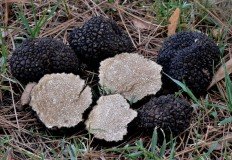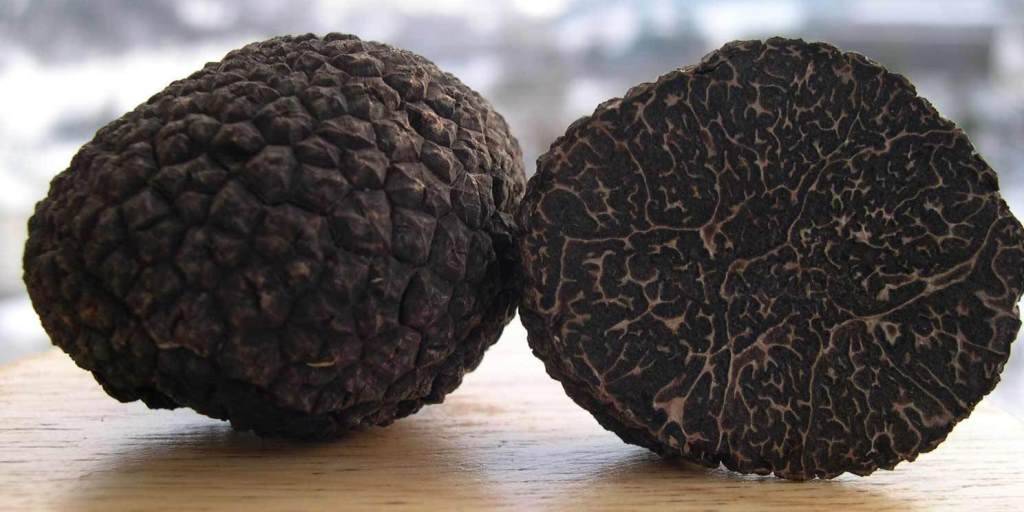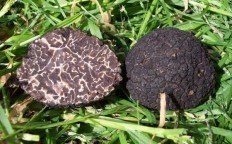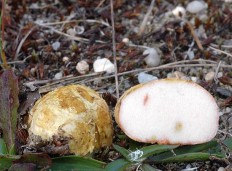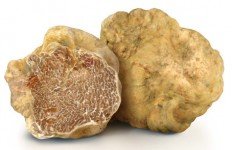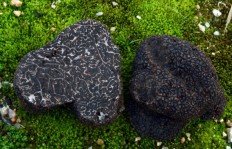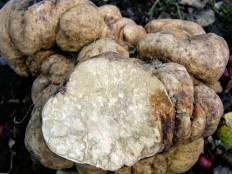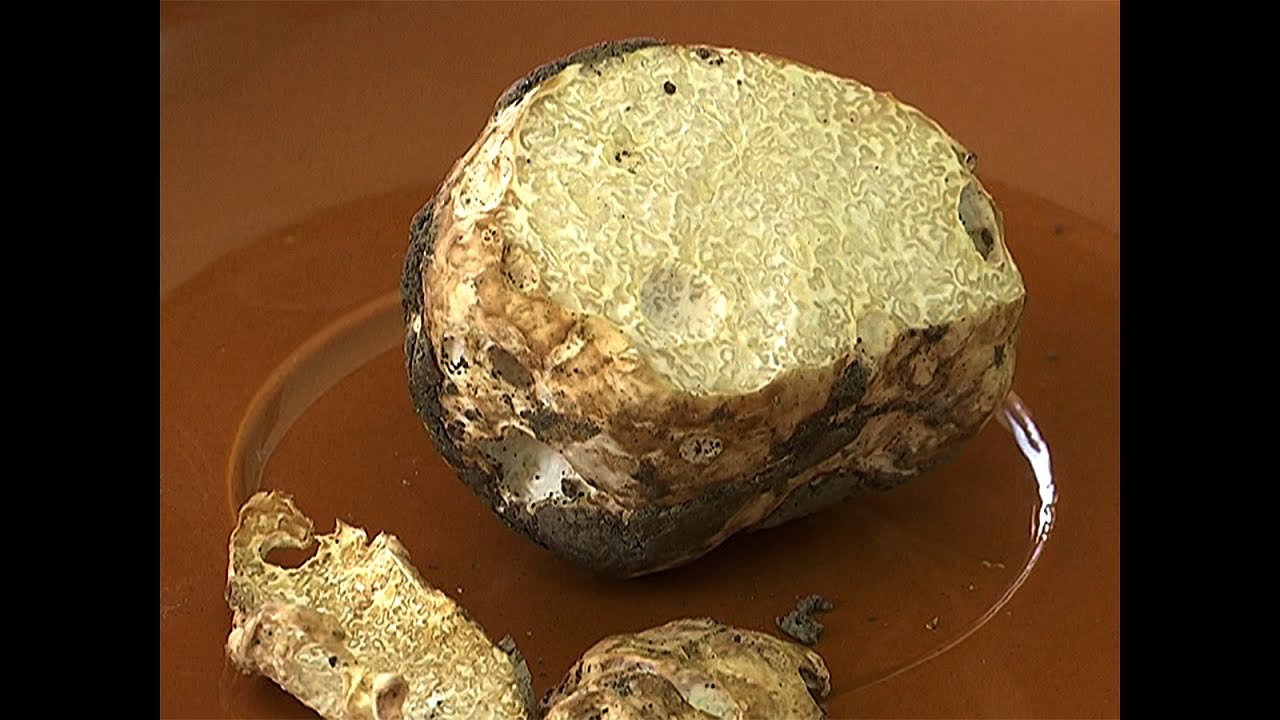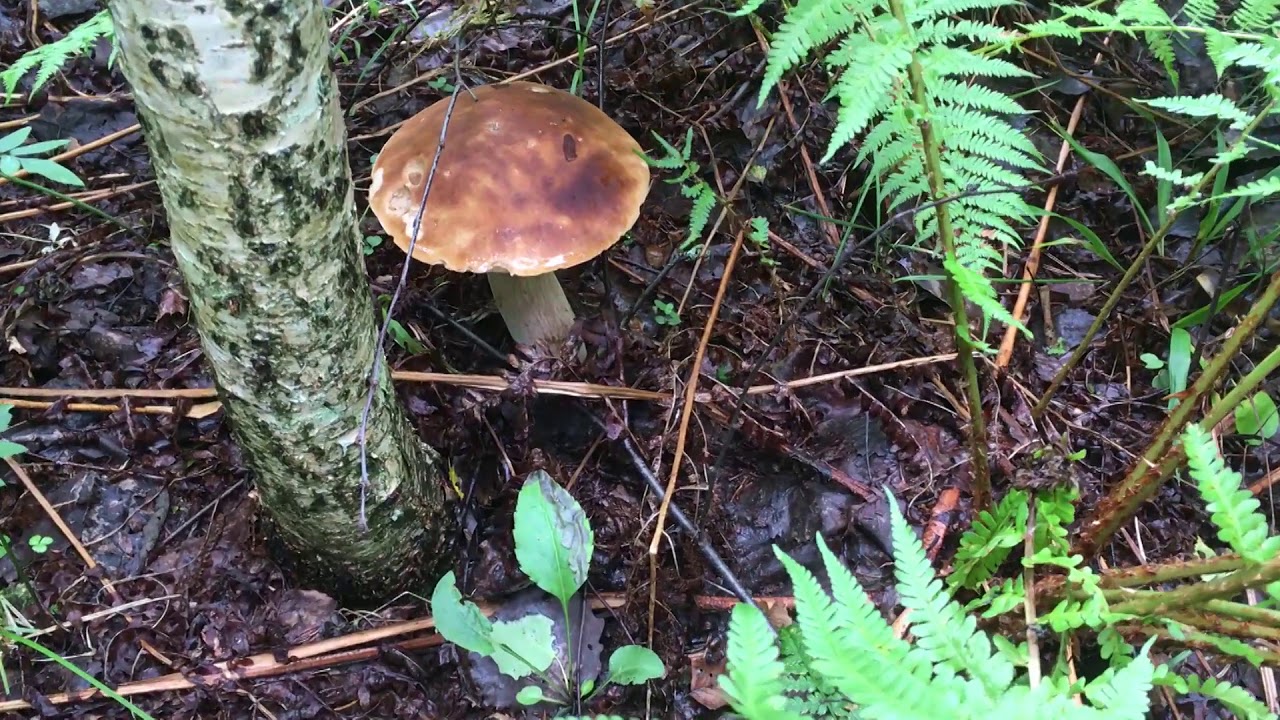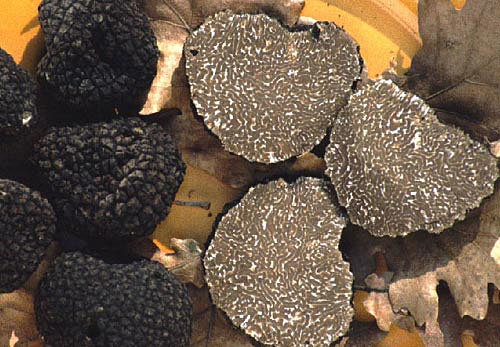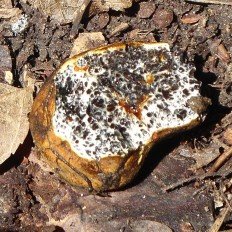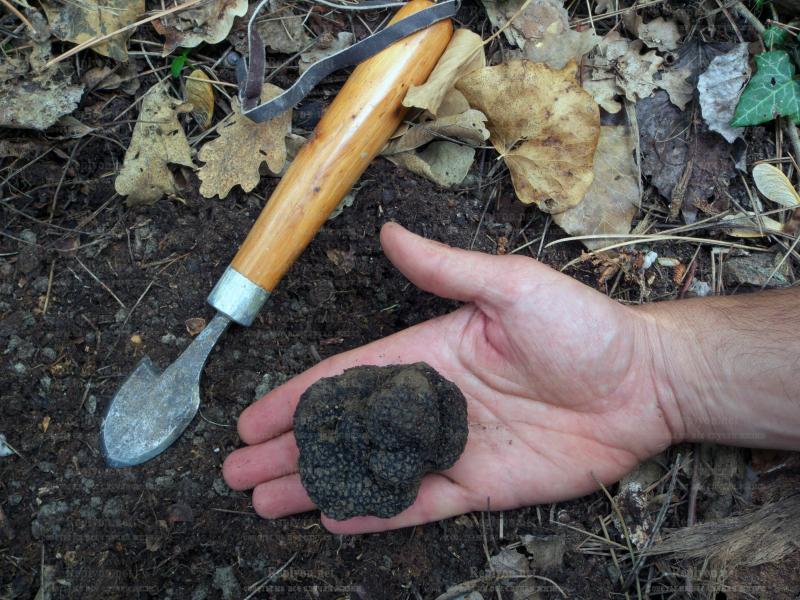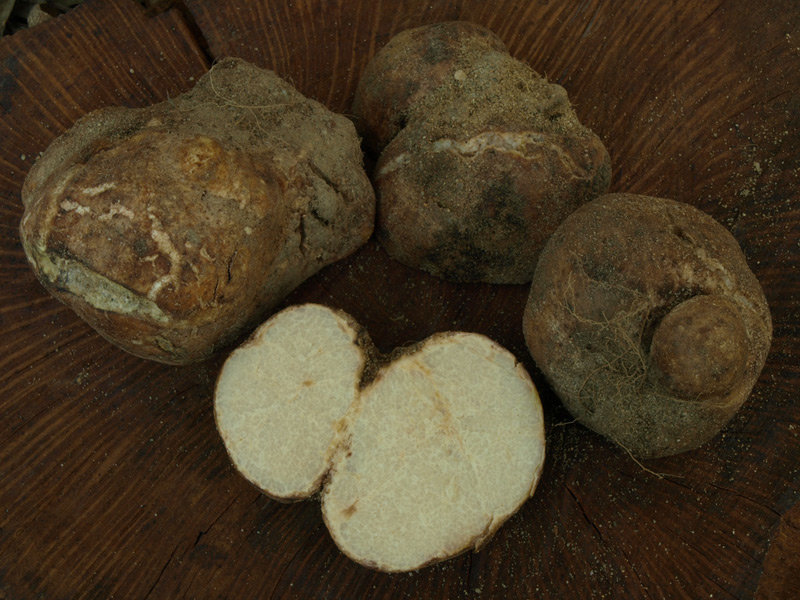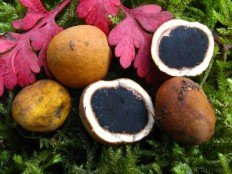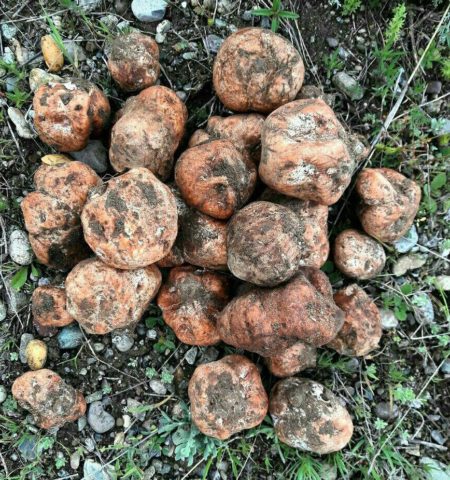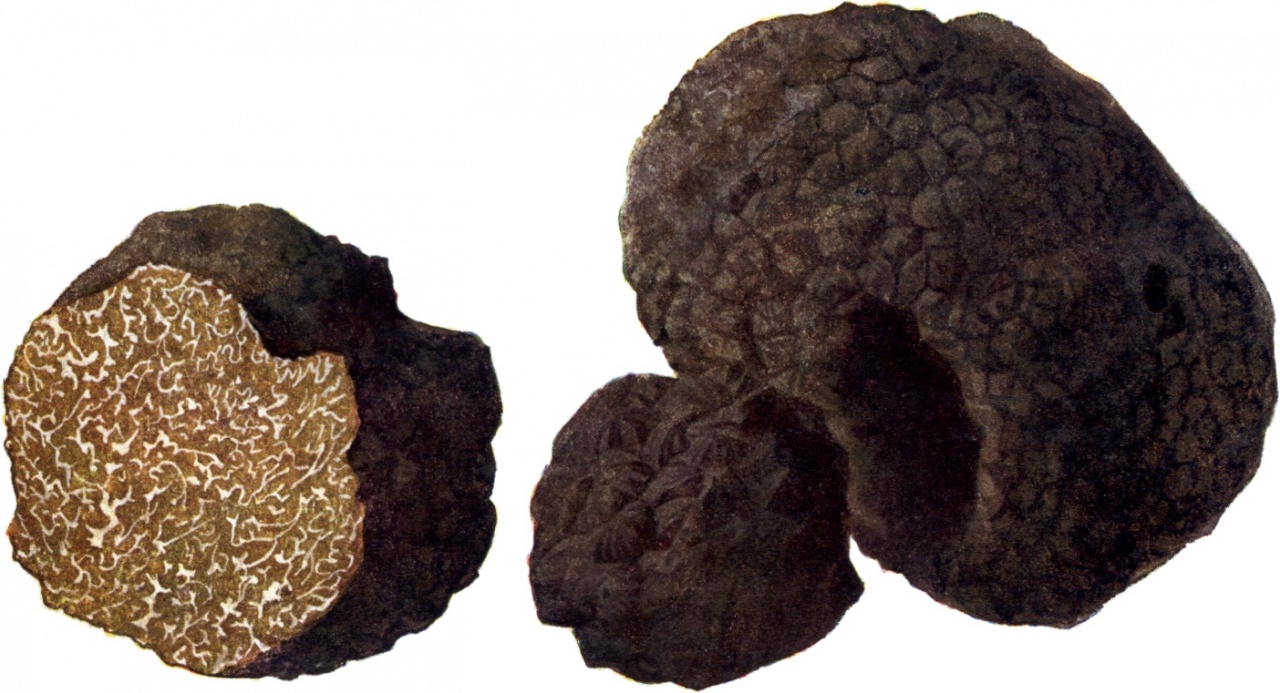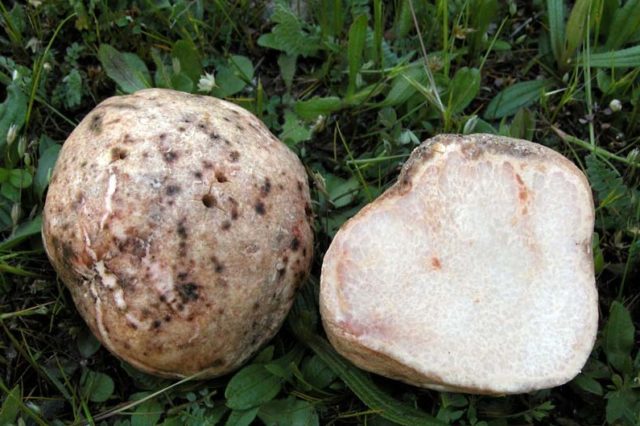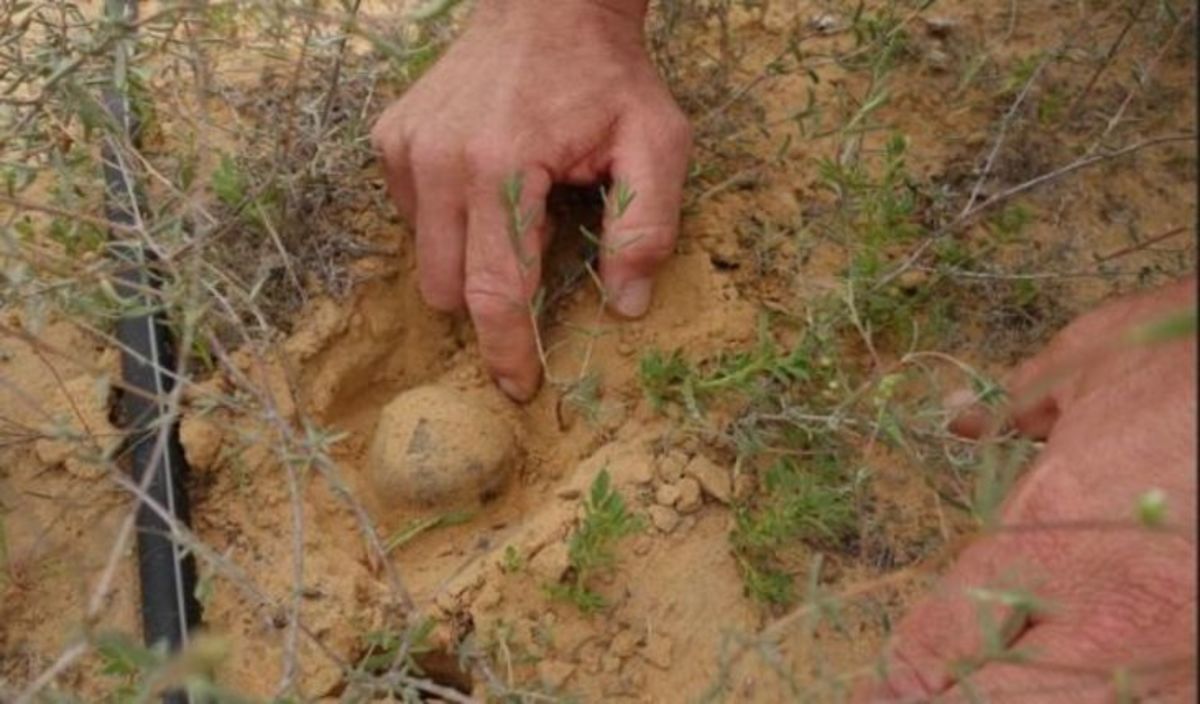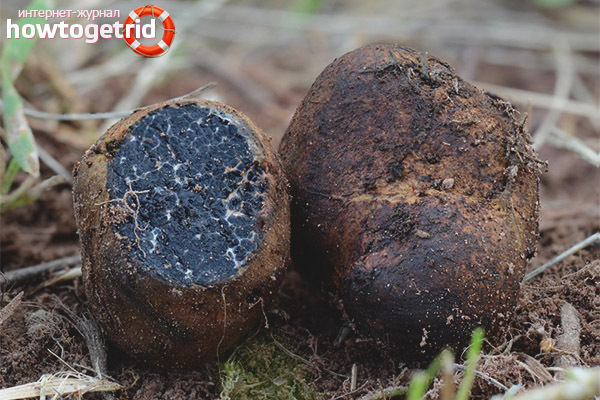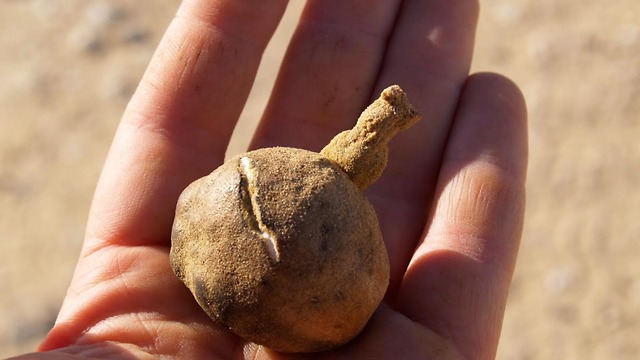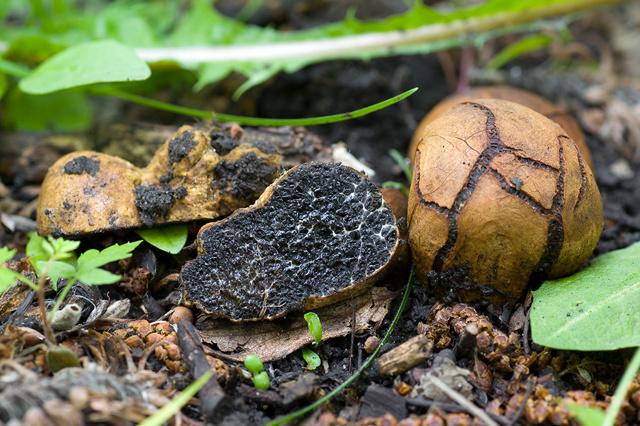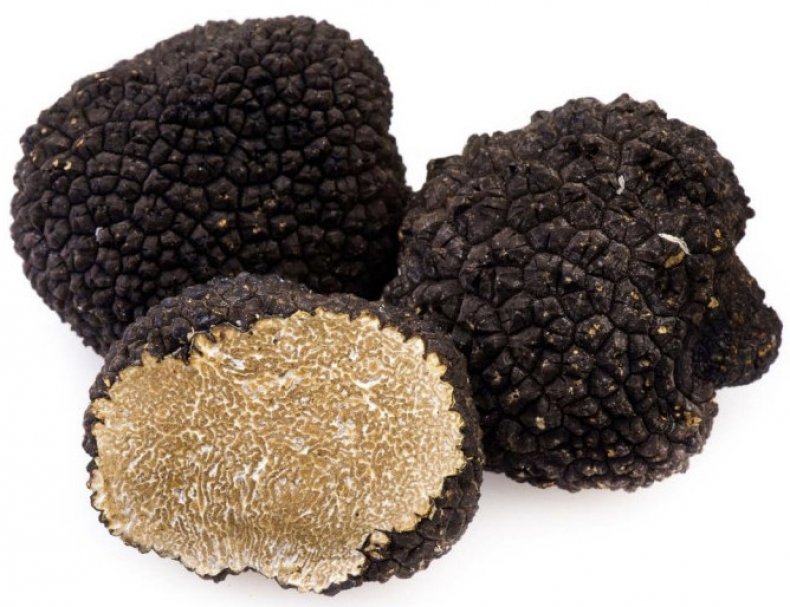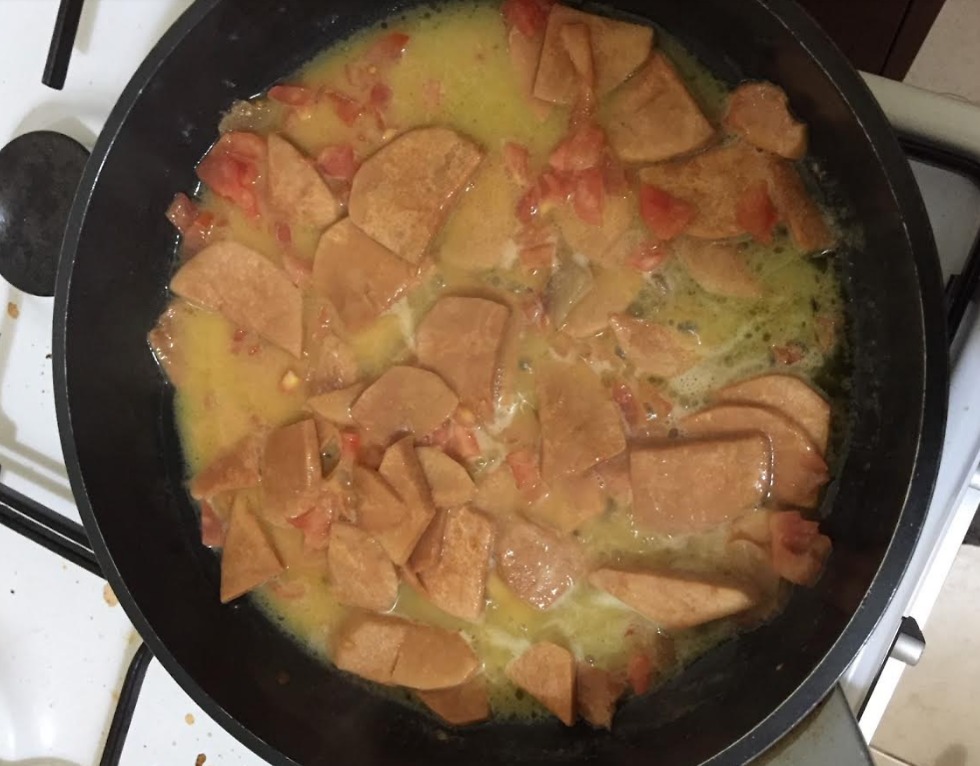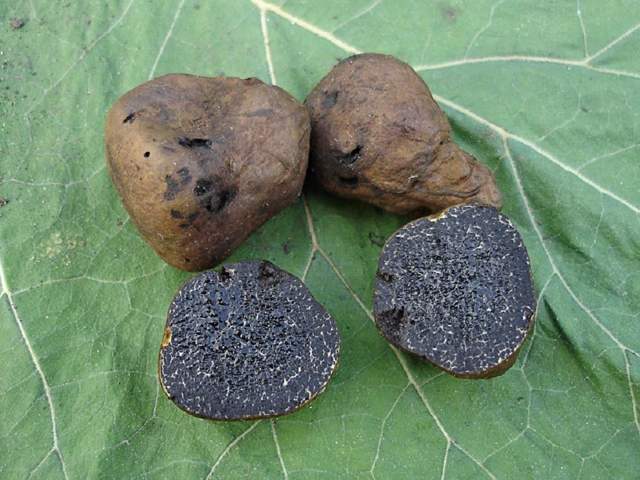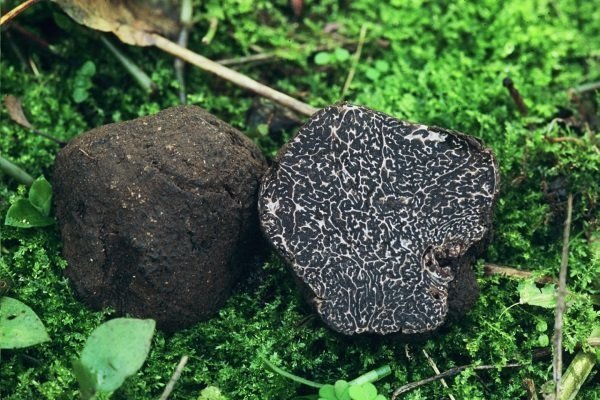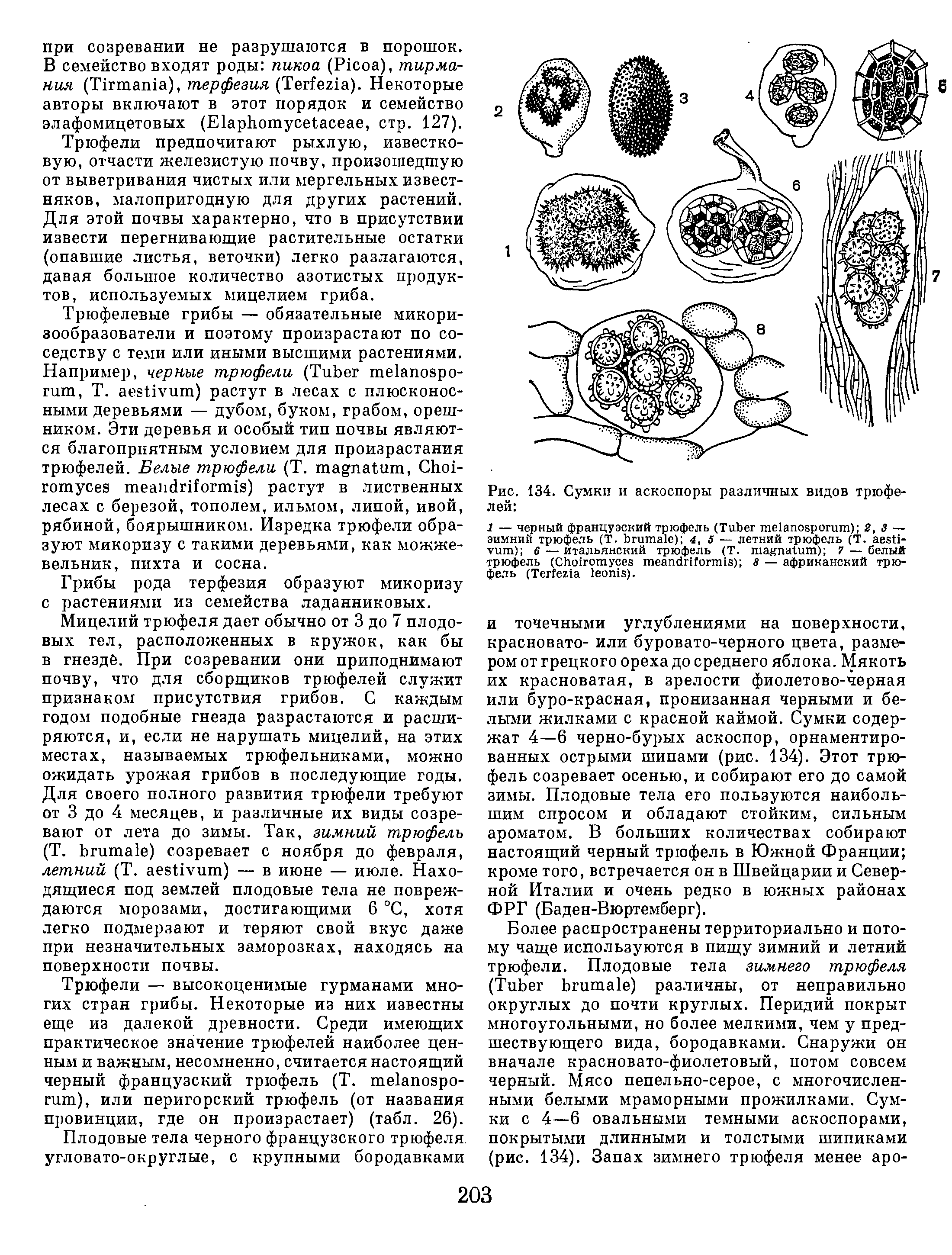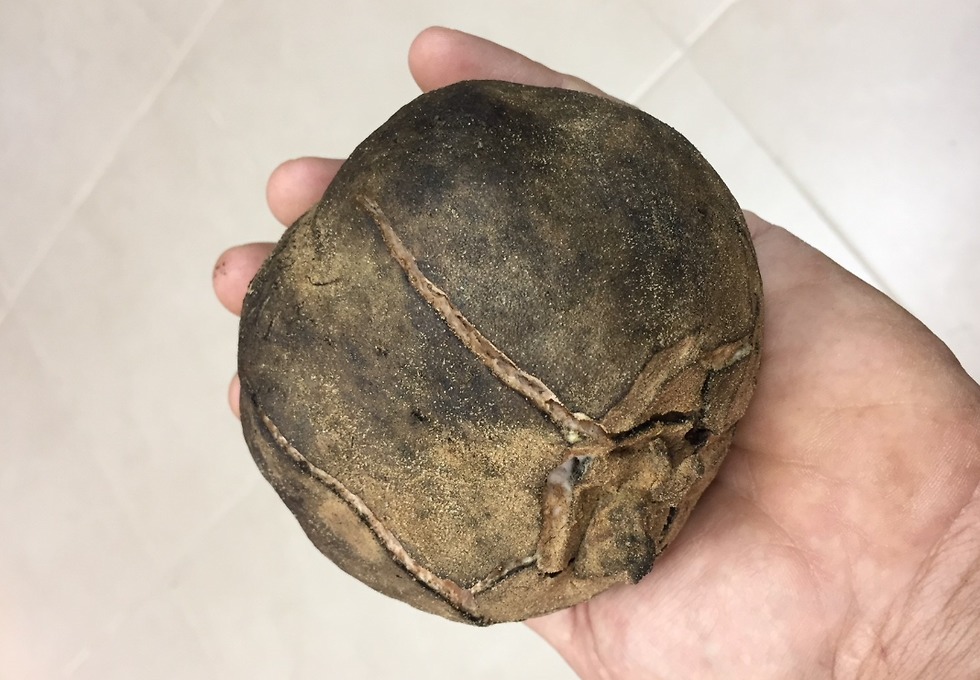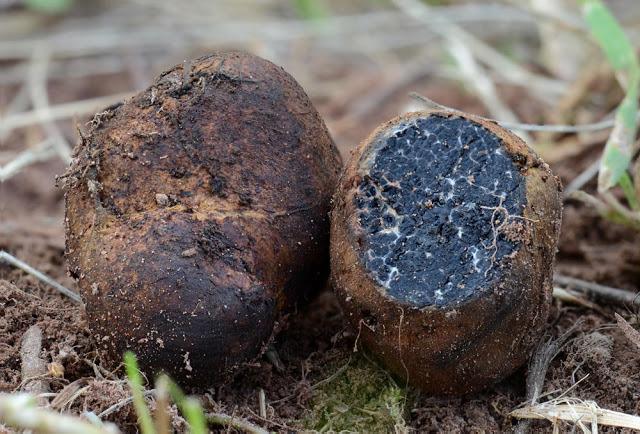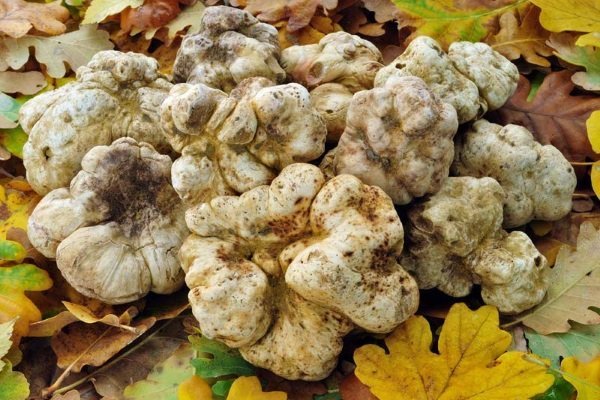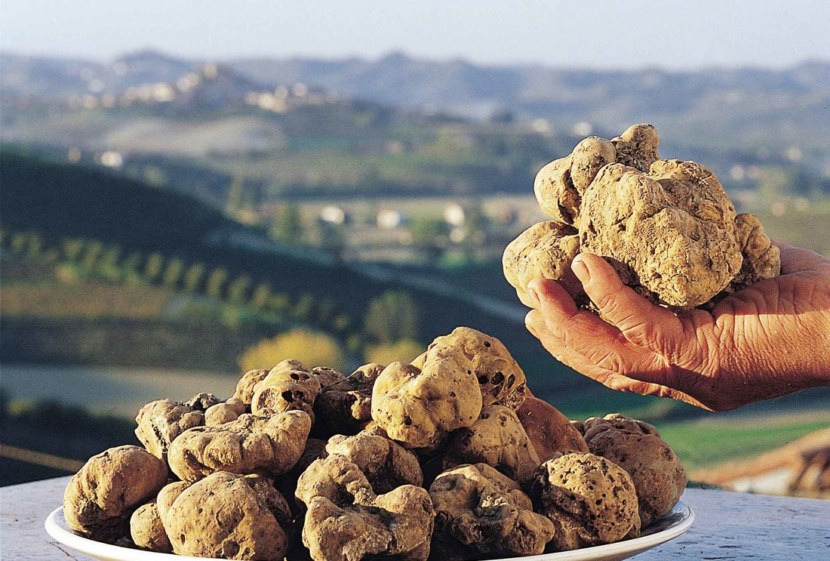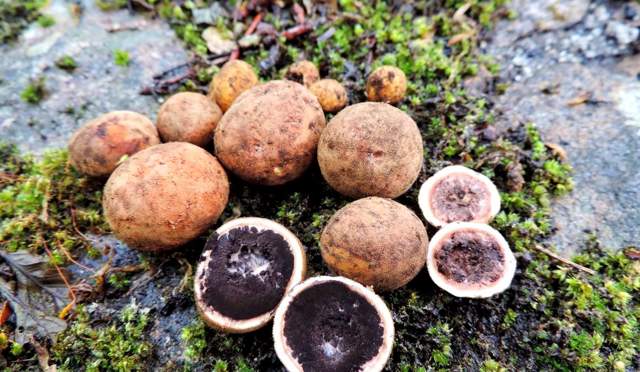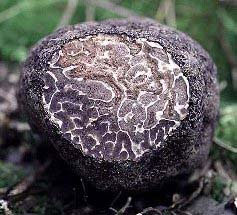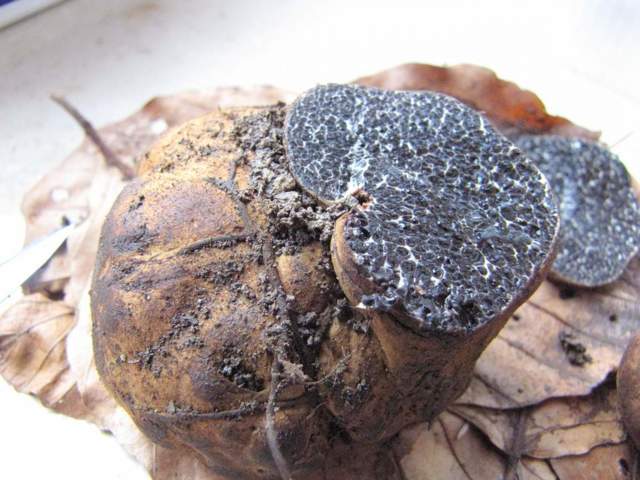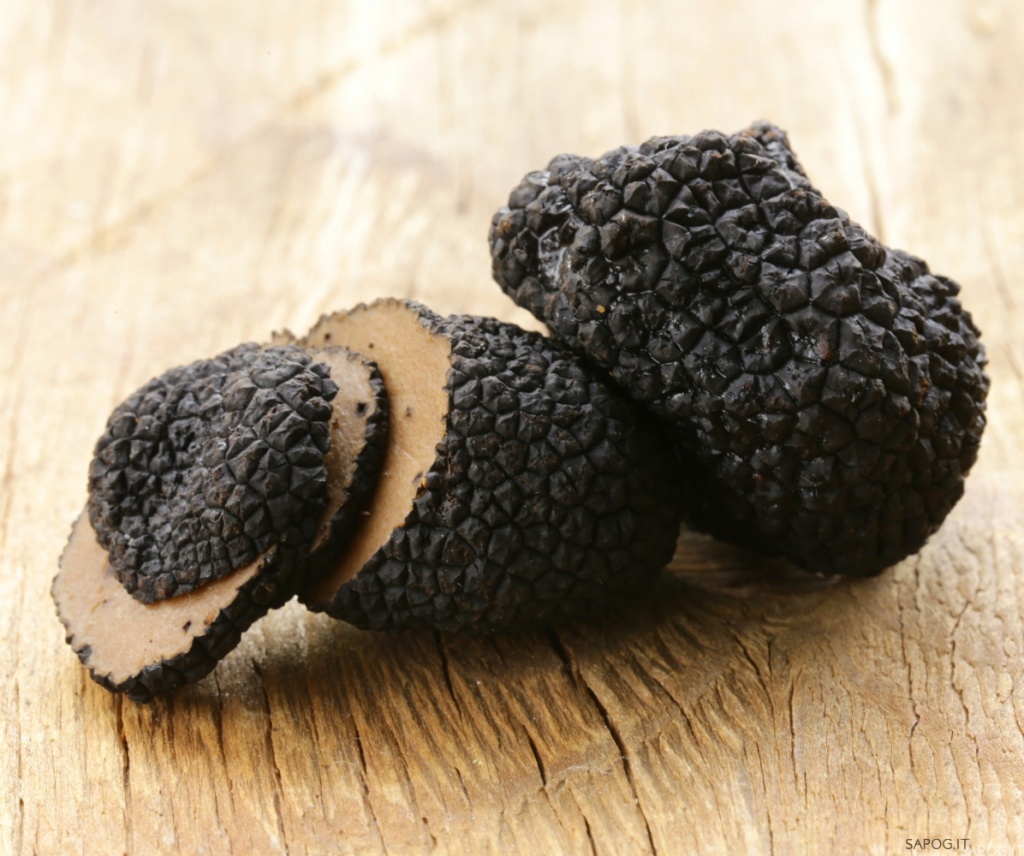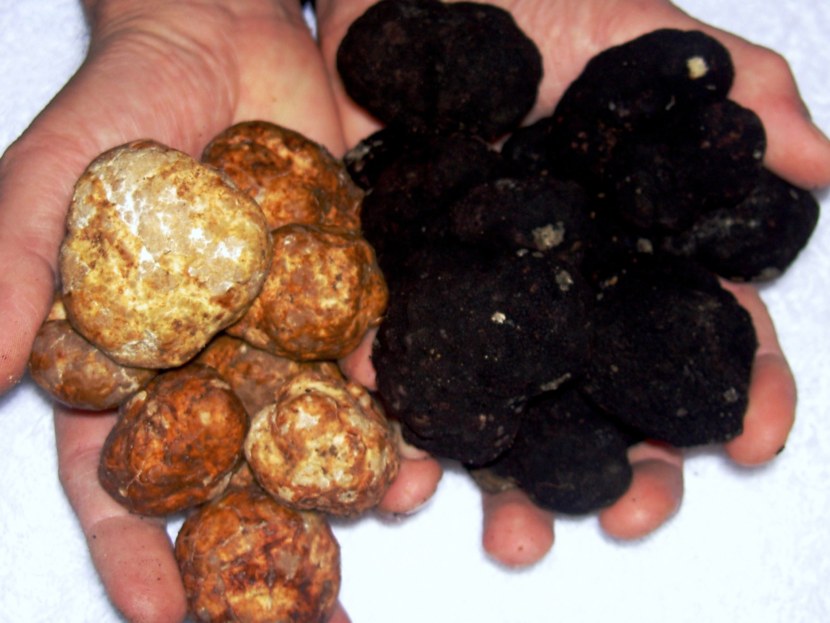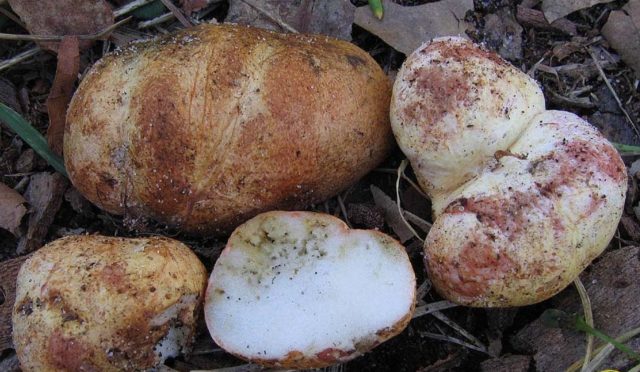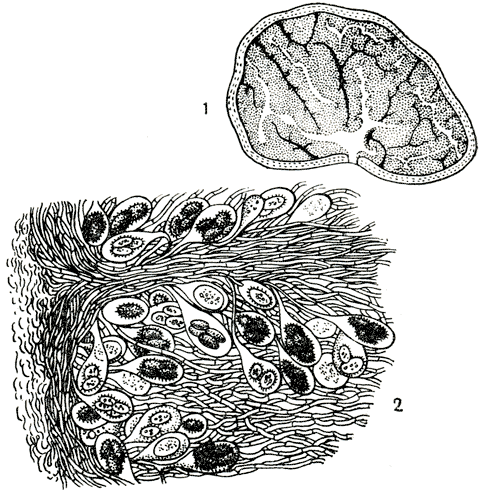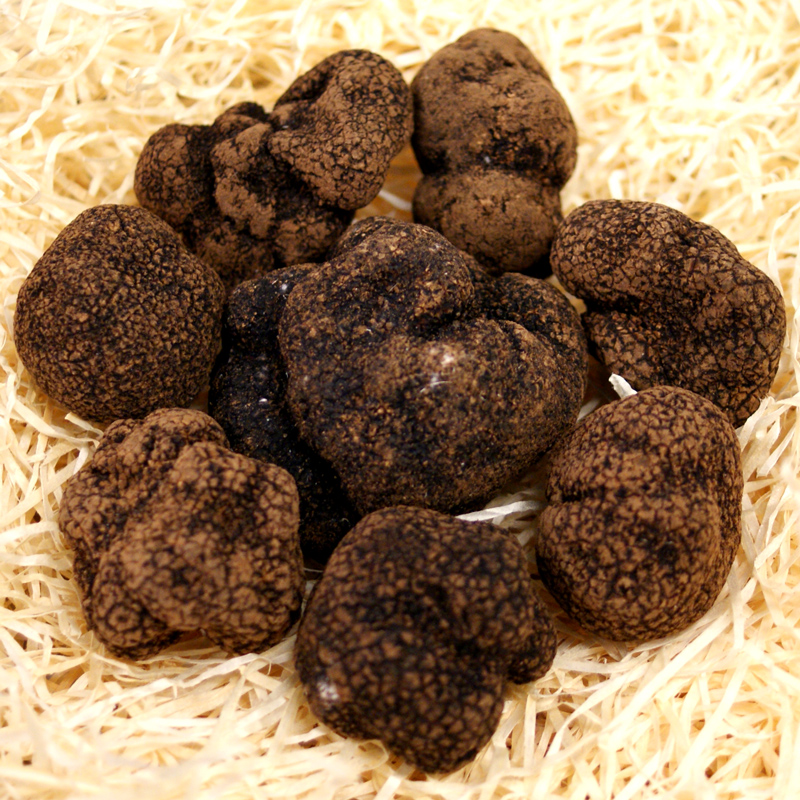Truffle varieties
There are many varieties of mushrooms, here are the most common:
- Truffle Italian (Tuber magnatum), real or "Piedmont" - its area is Piedmont (region of Italy). It grows near birches, lindens, elms. This is the most expensive mushroom in the world. It is appreciated for its pleasant taste and cheese-garlic aroma.
- French black (Tuber melanosporum), "Perigorsk" is found in groves where hornbeams, beeches and oaks grow. It is considered the second most valuable, second only to Italian. A red-brown or brown-black truffle with an angular-rounded shape, covered with large warts and small depressions. The pulp is colored reddish, later it turns purple. Its distinguishing feature is the multitude of white and black veins with a red border on the section of the mushroom. The mushroom has a bitter taste with a strong aroma.
- Truffle black "Burgundy" (Tuber uncinatum) - a variety of French black, with a nutty aroma and taste of chocolate, grows throughout Europe.
- Summer truffle (Tuber aestivum), "black Russian" is recognized by its nutty taste and sweetish aroma of algae. It can be found on the Black Sea coast of the Caucasus, in the deciduous forests of the Scandinavian countries, Central Europe, Ukraine, in some areas of Central Asia. It ripens in the summer months.
- Winter truffle (Tuber brumale) ripens in November - February. Hiding in the ground, it is not damaged by frost, but if somehow the mushroom is on the surface, then it freezes and loses all its taste. This happens even with the smallest frost. It grows in Switzerland, Italy and France, in the mountains of the Crimea. The young mushroom has a reddish-purple color, the mature mushroom becomes almost black and grows overgrown with many small warts. The ash gray flesh has white veins and a musky aroma.
- African truffle (Terfezia leonis) grows exclusively in North Africa and in parts of the Middle East. Whitish-yellow mushrooms are round in shape. The pulp is light, mealy, with white veins and numerous dark spots. When ripe, it becomes moist.
Truffle (Tuber) is the most expensive mushroom in the world, a rare and tasty delicacy with unique taste and strong specific aroma. The mushroom got its name due to the similarity of its fruiting body with potato tubers or cones (the Latin phrase terrae tuber corresponds to the concept of “earthen cones”). Mushroom truffle belongs to the department of ascomycetes, the subdivision of Pezizomycotina, the class of pec, the order of pec, the family of truffles, the genus of truffles.
How to find truffles
To find a truffle in the forest, you need to have special knowledge. They are found near the roots of trees: they are often found near oak trees. Try not to look for fruits in the clear cut areas. Based on practice, such areas are not distinguished by a large number of mushrooms. It is desirable that there be black soil with high humidity. Before starting your search, consider the following:
- Consider the fruits in advance, live or in photographs.
- Prepare to search for animals: Specially trained pigs or dogs will do.
To make the "quiet hunt" successful, be guided by some features of the area. The rules for mushroom pickers are as follows:
The "truffle" area, where the delicacy is located, is distinguished by stunted vegetation, gray-ash soil.
Fungi rarely come to the surface of the soil (sometimes this happens due to strong winds or heavy rains), so look for them in the ground at a depth of 10-15 cm.
Pay attention to the bumps, they should be excavated.
Midges often circle over a place with mushrooms: the larvae feed on mushrooms, so the insects lay eggs nearby.
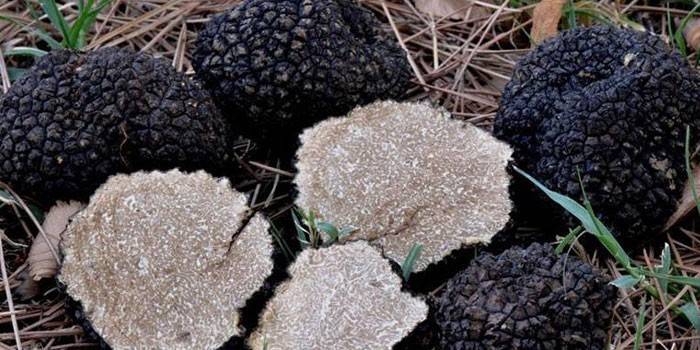
Growth features
A favorable place for the development of truffles is a large number of tree roots and soil with loose soil with a lot of sand and lime. Experienced mushroom pickers say that if they find one specimen, then you need to continue looking for several more nearby. Typically, you can find about 5 pieces. Truffle often develops in families, rarely singly.
Searching for truffles in the forest
People have been collecting unusual mushrooms for many years.
It is important to consider that there is a false and real mushroom. To return home with the desired prey, it is important to follow a special technology:
- Go to the forest where there are beeches, birches, oaks, hazel.
- Look for fruits near trees with large roots.
- If the search is carried out with the help of pigs, then they should be muzzled, because animals love to feast on mushrooms.
- Keep in mind the appearance of the plant: its surface is rough, the flesh is firm. The fruits resemble black or white potato tubers.
Truffle hunting animals
Mushrooms have a very strong odor that animals can easily pick up even at a distance. For this reason, experienced mushroom pickers prefer to keep specially trained dogs or pigs. The latter are able to smell at a distance of 25 meters. After the aroma is determined, the pig will actively dig up the delicacy. If there is no muzzle, then it is necessary to ensure that the pig does not eat what it finds.
As for dogs, they are indifferent to eating treats, so it is not necessary to wear a muzzle before searching. Before using these four-legged "detectives", it will take a long time to learn the rules of finding mushrooms. The dog needs to be trained to smell. If you are thinking of buying a trained dog, then keep in mind that it costs more than 5000 euros.
Ecology, area
|
Conservation status NatureServe Presumably in good conditionApparently Secure: |
It grows under oak and some conifers (spruce, pseudo-lump, hemlock, pine).
It is widely distributed in Europe, it is known from the following countries: Austria, Belgium, Bulgaria, Great Britain, Hungary, Germany, Denmark, Lithuania, Luxembourg, Poland, Russia, Serbia, Slovakia, Slovenia, Ukraine, Czech Republic, Switzerland, Sweden. There is a report on the finding of a white truffle in Antarctica. In North America, it is known from Oregon, California, and West Virginia.
A rather rare species throughout its range: it is included in the Red Data Books of Germany (under a serious threat of extinction), Denmark, Lithuania (endangered), Bulgaria, Poland (rare), Switzerland (close to vulnerable). Until 2005, it was included in the Red Book of Sweden as a species with an unclear status, in the 2010 edition it was excluded from it.
Recipes and cooking features
Since truffle is a very expensive mushroom, and dishes made from it have a special taste, the rules for preparing the product are important:
- White truffle absolutely must not be heat treated, otherwise it will lose its taste and aroma.
- The mushrooms are soaked in water to form a base for flavorful sauces.
- Store only dry, wrapped in a paper towel, in the refrigerator, and no longer than two weeks.

There are many recipes for this incredible product.
Creamy truffle soup:
- turkey fillet - 120 g;
- water - 240 ml;
- onions - 32 g;
- celery root - 80 g;
- ground black pepper and salt - to taste;
- butter - 20 g;
- cream - 60 ml;
- truffles - 16 g;
- bun - 28 g;
- olive oil - 4 ml.

Boil the turkey fillet in salted water, cool and cut into cubes. Finely chop the onion and celery and fry in butter for 20 minutes. Combine the fried ingredients with the turkey broth and bun, boil for 15 minutes. Add meat and beat with a blender. Add cream and bring to a boil. Then combine with pre-cut truffles. Sprinkle with olive oil before serving.
Truffle Pasta:
- pasta - 150 g;
- butter - 25 g;
- cream - 100 ml;
- parmesan - 100 g;
- truffles - 20 g;
- salt and ground black pepper to taste.
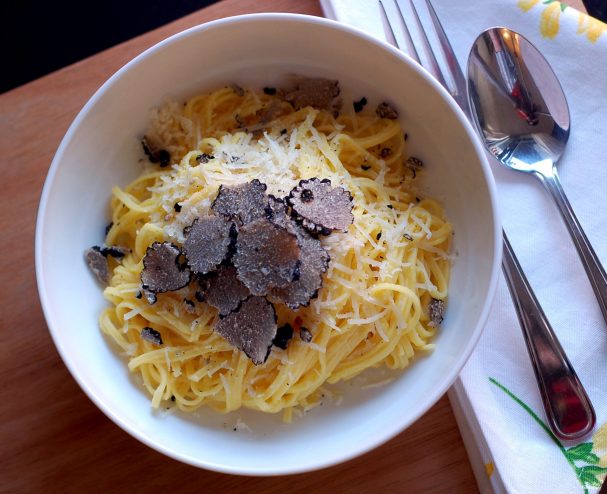
Boil the pasta, grate the parmesan.Melt the butter and pour the cream into it, add half a serving of Parmesan. Mix everything and keep on low heat for 5 minutes, salt and pepper. Combine the pasta with the sauce, sprinkle with parmesan on top and lay out the truffle slices. Serve immediately.
Growing truffles at home
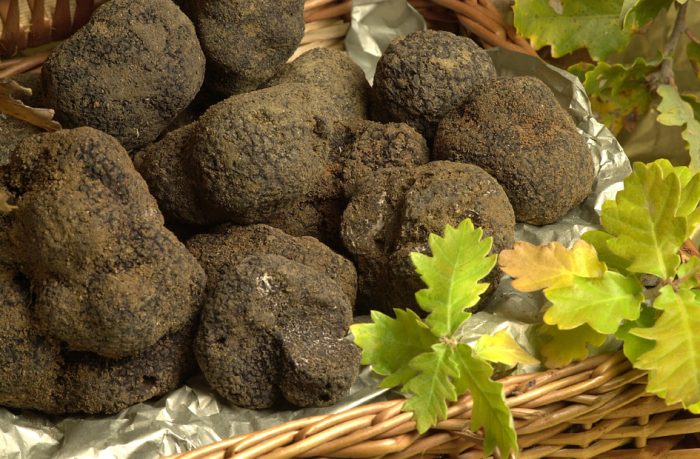
As a substrate for growing truffles, sprouts of oak or common hazel are used. Seedlings are kept under sterile conditions for several weeks to allow the mycelium to take root. After that, the seedlings are planted in the nursery.
The soil for growing truffles should have a pH of 7.5-7.9, a high content of humus and calcium. It should not contain stones, weeds and should not be infested with other types of fungi. Before planting, deep mechanical processing is performed. Before planting, the soil is not fertilized. The environment must be dry, with an average temperature of 16.5-22 ° C.
Seedlings are planted in spring. No more than 500 trees per hectare. A little water is poured into the hole, the seedling is firmly covered and watered again. The planting depth is 75 cm. The top layer of forest soil with fallen leaves and plastic wrap are placed next to each seedling.
The edible part of the truffle is the spore-containing fruiting body. Fruit bodies are located at a depth of about 20 cm. They are dug out with small shoulder blades. An indicator of the availability of a truffle crop is the so-called truffle flies.
Features of the mushroom
Truffles are unusual, first of all, in that the fruit bodies are formed not on the ground, but inside it. Rounded or tuberous mushrooms have a fleshy and cartilaginous consistency. Their peculiarity is the marble pattern - the alternation of light and dark streaks on the cut. Light veins are called internal veins, and dark veins are called external veins. Spore sacs form on the internal veins and are also distributed by nests in the fruiting body. Mushrooms grow to different sizes. They can be the size of a walnut or potato tuber.
Young mushrooms have a smooth whitish skin that turns yellow over time and becomes light brown. The surface is covered with various folds, cracks and hard "warts". The yellow-whitish dry pulp with numerous brownish veins-convolutions turns brown when heated, and acquires a chocolate hue.
Truffle is an edible mushroom of the first category with the best consumer and culinary qualities. They are most often used fresh for making aromatic soups, sauces and gravies.
Where do truffles grow and how do you collect them?
It is not easy to find a truffle in the forest; it hides well underground. Summer mushrooms are harvested in summer and autumn, with a peak in August - September. They go for winter species in February and look for them until March.
The fungus grows in deciduous, mixed European forests, less often in conifers, as well as on the African continent (in its northern part), Asia and America. He needs moderately moist clay-calcareous soils with an underdeveloped herbaceous cover, on which he forms mycorrhiza with roots of various tree species. Truffles usually grow in small groups of 7.
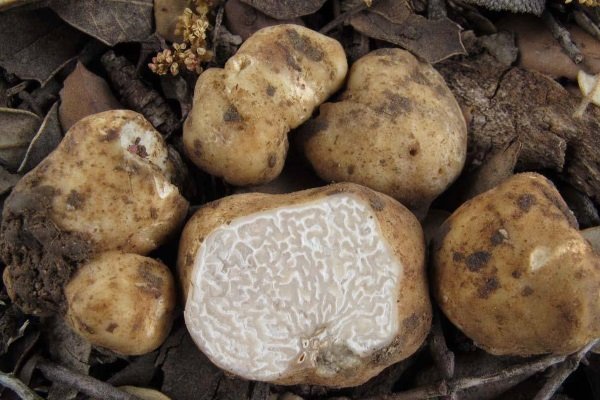
Experienced truffle hunters notice hidden mushrooms by insignificant external signs - it is raised soil and dried grass. In France, it is customary to look for them with the help of truffle flies, which lay the larvae in the ground near this mushroom. The flight of these insects, their large concentration indicates the close location of the truffles.
But not all such "trackers" are, therefore, to search for a delicacy, trained animals have been used since ancient times, which are able to smell the peculiar smell of truffles from 20 m. start. In Italy, dogs are used for searches; poodles and mongrels have become the best search engines. It is interesting that trained bears were looking for truffles near Moscow until the 1869s.
Taxonomy
At present, the type species of the genus Choiromyces meandriformis based on morphological characteristics, it is usually recognized as identical to the previously described Mylitta venosa... In this case, the correct name is Choiromyces venosus... However, molecular genetic studies of the type samples of these taxa, which could confirm or deny their synonymy, have not been carried out.
Synonyms
- Choiromyces gangliiformis Vittad., 1831
- Choiromyces gibbosus (Dicks.ex) J. Schröt., 1893
- Choiromyces meandriformis Vittad., 1831typus
- Lycoperdon gibbosum sensu Dicks., 1790
- Mylitta venosa Fr., 1830basionym
- Rhizopogon albus (With.ex) Wallr., 1833
- Rhizopogon meandriformis (Vittad.) Corda, 1854
- Tuber album With., 1796, nom. illeg.
Why are truffles so expensive?
The high cost of truffles is due to the fact that very few of them are "mined". This mushroom does not grow in every forest or even in every region. In addition, it is not so easy to find it, because it does not come to the surface. And completing its uniqueness is that it is a seasonal product.
Add to this a pleasant taste and a breathtaking aroma - that's what we get a rare expensive delicacy.
By the way, the cost of a white truffle can reach 4 thousand euros / kg. The larger it is, the more expensive it is. The black cousin will cost between $ 1,500 and $ 2,500 per kilogram.
It is believed that once you have tasted this outlandish mushroom, its taste and aroma will forever remain in your memory. In addition to its taste, this product is also very useful for the body. Gourmets advise: if you have the opportunity to taste this delicacy, do not miss it.
Description of the mushroom
Black truffle (Tuber melanosporum) belongs to the Truffle family and Truffle genus. The mushroom is also called Perigord truffle, or black French. This revised name is due to the fact that most of the range falls on the French region of Perigord. This type is the most sophisticated and expensive.
Appearance
The mushroom has an external form of a tuber disproportionate in its structure. The body has 4 to 6 faces. The diameter of the tuber is 7-8 cm. The weight of one mushroom is up to 400 g. The color of the surface of the fruiting body depends on age. Young truffle is dark brown in color. Over time, the top layer turns charcoal black. If you press on the surface of the body, the color will turn dark orange.
The pulp is light, darkens over time from ripening spores and acquires a purple hue. The structure of the body is marble, with many white or light pink veins. The taste of the pulp is intense, characteristic with a chocolate note and light bitterness. The aroma is pronounced.
Microscopically small spores are oval or fusiform, strongly curved. The color of the spore powder is dark brown. Fruiting of the species lasts from early December to mid-March.
Places of growth
The Perigord black truffle grows not only in Perigord. Mushrooms of this species are found in other regions of France:
- Dordogne;
- Vaucluse;
- Gironde.
The species is also found in the north of Spain and Italy. China is the world's leader in the number of artificially grown black truffles. The Chinese counterpart is more common due to its low price. However, the quality of such mushrooms is significantly inferior to French ones.
Similar species
Besides the classic black truffle, there are other varieties with similar characteristics:
- Russian summer black truffle (Tuber aestivum): the fruit body reaches 12 cm in diameter, the mass of the mushroom is up to 450 g. With age, the color of the pulp changes from white to gray-brown. The taste gives off nuts. Places of growth - Crimea, the Caucasus, the European part of Russia. The species grows under pine and oak trees. The fruiting period is from June to mid-October.
- Black Burgundy truffle (Tuber mesentericum): this species is characterized by a rounded shape and weights up to 310 g. The diameter of the fruit body is up to 9 cm. The pulp has a light brown tint with a marble structure. The aroma contains notes of cocoa.
- Black winter truffle (Tuber brumale): rounded fruiting body, 7-20 cm in diameter. The mass of the mushroom reaches 120 g. The surface of the body has a purple hue and is covered with growths. The aroma is musky, pronounced. The fruiting period occurs in early November - mid February. Requires hazel or linden for growth. Growing places - Italy, Ukraine and southwest Switzerland.
- Himalayan black truffle (Tuber himalayensis): fruiting body usually weighing up to 50 g, with a pronounced nutty flavor. Finding tubers is difficult due to their small size.
Growth features
The mushroom grows at a depth of 35 cm
Truffle belongs to marsupial mushrooms.Such species have the following growth characteristics:
- The edible body is in the ground, at a depth of 10 to 35 cm.
- The soil for growth must contain lime in its composition.
- Certain tree species are essential for the good development of a truffle.
The black truffle species needs hazel or oak roots to form mycorrhiza. Other trees are not suitable for proper development.
The tree provides the truffle with the necessary complex of minerals, and the mycelium enhances the ability of the root system to absorb water and salt.
Practical value
Real truffles are edible. They have a mushroom flavor with deep roasted seeds or walnuts and a strong characteristic aroma. If a truffle is immersed in water and held, then it acquires the taste of soy sauce.
The most appreciated by gourmets are Perigord, Piedmont and winter truffles, which grow in oak and beech groves in Southern France, Switzerland and Northern Italy, where they are of great industrial importance. In Russia, one species is found - summer truffle (Tuber aestivum).
In France and Italy, dating back to the 15th century, the practice of searching for truffles growing in the forest with the help of specially trained search dogs and pigs, which have a phenomenally fine scent, is widespread: they are able to smell truffles underground at a distance of up to 2000 m. searching for truffles is also the so-called "Hunting for flies"; it is based on the fact that some flies from the family lay eggs in the soil in the vicinity of truffles (the larvae of these flies use the fruiting bodies of truffles for food), therefore, a truffle can be found under the foliage, having noticed midges swarming above it.
Contrary to popular belief, truffles can still be cultivated. There were already successful attempts in 1808. It was noticed that truffles only grew between the roots of some oak trees. In 1808, Joseph Talon (Joseph talon) planted acorns from those oak trees under which truffles were found. A few years later, when the trees grew, truffles were found under the roots of some of them. In 1847 Auguste Rousseau (Auguste Rousseau) planted 7 hectares of such acorns and subsequently collected a large harvest of truffles, for which he received a prize at the 1855 World Exhibition in Paris.
At the end of the 19th century, 750 square kilometers were planted with truffle groves, from which up to 1000 tons of "black diamonds of culinary" were collected. However, due to the decline of agriculture in France in the 20th century, many of the truffle groves were abandoned. The average fruiting period of truffle oaks is about 30 years, after which the yield drops sharply. As a result, although 80% of all truffles harvested in France come from special oak plantations, the annual harvest has dropped dramatically. Local farmers are opposed to new plantations, fearing a serious drop in prices for this delicious mushroom. The number of harvested truffles is decreasing from year to year. In recent years, the harvest of these mushrooms has not exceeded 50 tons. Currently, truffles are cultivated in the USA, Spain, Sweden, New Zealand, Australia and the UK.
French experts demand to ban the mixing of European truffles and Chinese ones, as this ultimately strongly affects the reputation of European products for which such mixtures are issued.
Other truffles
White, or Polish, or Trinity truffle (Choiromyces meandriformis) has a fruiting body with light pulp, similar in appearance and size to a potato. Edible. It grows in the forests of Western Europe, Ukraine, Belarus, as well as in the regions of central Russia (earlier it was mined in large quantities in the vicinity of Aleksandrov and Sergiev Posad).
Among the so-called steppe truffles, "tombolans" (genus Terfezia) are also edible. They grow in Southern Europe, North Africa, South-West Asia - in Azerbaijan on the Absheron Peninsula, in Nagorno-Karabakh, in the valley of the Araks River, in Central Asia and in Turkmenistan (Terfezia transcaucasica). In the same areas, the steppe truffle grows (Terfezia boudieri).
Sometimes truffles are mistakenly referred to as inedible basidiomycetes from the genus Scleroderma (a group of gasteromycetes), whose fruiting bodies look like round and oblong yellowish tubers 3-10 cm long; found in forests, parks; fruiting bodies are at first dense, blackish inside with light veins, unpleasant smelling; later their contents are sprayed.
Reindeer truffle, inedible for humans, is a species of the Elafomitses genus, which serves as food for rodents and deer.
Choosing wine for truffles

Truffle is considered a gourmet delicacy and the most expensive mushroom in the world. The fruiting bodies of truffles are deep underground and are characterized by a round or tuberous shape. Mushrooms form mycorrhiza with tree roots. Truffles come in over a hundred varieties. Conventionally, they can be divided into black, which are more common, and white, more rare and therefore more valuable.
They grow in countries with warm, temperate climates. Their production is widespread in France, Germany, Spain, Italy, Portugal. The most valuable and expensive are black truffles, which are obtained in Perigord in France, and white ones, which grow in Piedmont and Umbria in Italy. Many are interested in the question: where does the truffle mushroom grow in Russia?
Where does white truffle grow in Russia?
This type of truffle is rare and therefore very valuable. In Russia, it grows in the average Volga region, Vladimir, Moscow, Smolensk, Tula, Oryol regions. White truffles grow from late autumn to early winter.
The size of the mushroom is up to 15 cm, weight - up to 500 g, in the soil it is at a shallow depth - up to 15 cm. Externally, a white truffle looks like it, it has a brown skin and light pulp. The truffle has a more meaty than mushroom flavor and a pronounced aroma.
Where does black truffle grow in Russia?
The black truffle that can be found in Russia is called summer truffle. Where does summer truffle grow in Russia? Its location can be called the Caucasus on the Black Sea coast. He prefers calcareous soils for growth. Its size reaches 10 cm, it grows in the ground at a depth of 10-15 cm. This type of truffle is harvested in late summer - early autumn.
In which forests do truffles grow in Russia?
The truffle mushroom prefers to grow near the roots of such trees: oak, birch, hornbeam, beech, walnut. Accordingly, they can be collected in forests where these types of trees are found. The greatest probability that the truffle mushroom grows in Russia in oak forests.
Propagation of truffles in nature
In nature, truffles do not reproduce in the same way as other mushrooms, in which spores are carried by wind or water. The only way the seeds (mycelium) of a truffle are spread is through animals. Since the seeds are deep underground, animals carry them when they search for mushrooms.
Truffle harvesting methods
Specially trained animals - pigs or dogs - are used to search for truffles. This is considered a real hunt, which takes place at night, as the smell of truffles is better heard at night. You can try to find mushrooms by looking at the numerous swarms of midges above the ground. If one truffle is found, then another 5-6 mushrooms will appear next to it. Collecting truffles is a very complex process. They must be dug up and collected very carefully, trying not to damage both the mushrooms themselves and the roots of the tree near which they grow.
Growing truffles
Growing truffles on artificially created plantations is a very laborious process that takes a lot of time. First, acorns are harvested from under the oak trees, next to which the truffles grew. Then a special soil is prepared: they mix the soil suitable for and the soil taken from the places where the mushrooms grew. Then prepared acorns are planted in this soil. Thus, young trees grow in soil containing truffle spores.
The first harvest is obtained in 6 years. You can harvest mushroom crops for 25-30 years. They will amount to 15 kg of truffles per hectare of land.
In Russia, truffle growing technologies are not widespread, this process is typical for other countries.
Truffles are a real delicacy. The cost of one kilogram of such mushrooms is estimated at thousands of dollars. You can try dishes from them in restaurants. How is truffle collection done?

